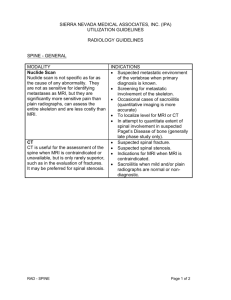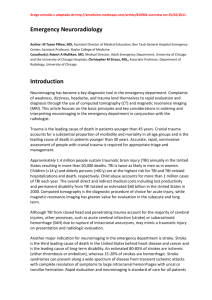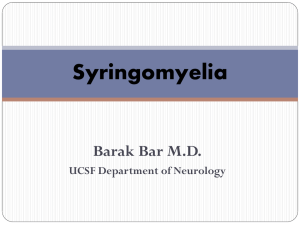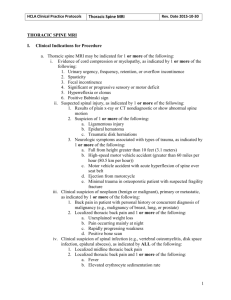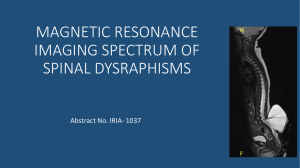CT PATHOLOGY
advertisement
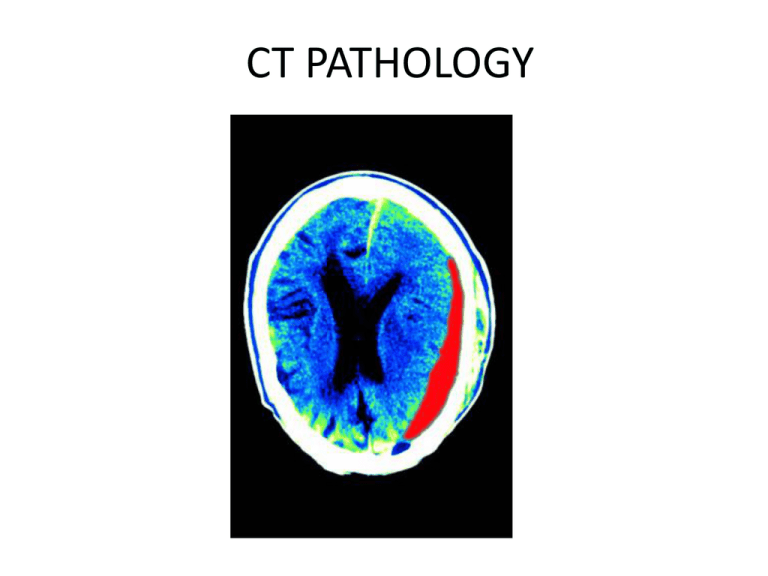
CT PATHOLOGY Subdural Hematoma Subdural hematomas are usually the result of a serious head injury. When one occurs in this way, it is called an "acute" subdural hematoma. Acute subdural hematomas are among the deadliest of all head injuries. The bleeding fills the brain area very rapidly, compressing brain tissue. This often results in brain injury. Subdural Hematoma Subdural Hematoma Stroke Symptoms If you have symptoms of a stroke, seek emergency medical care. General symptoms of a stroke include: Sudden numbness, paralysis, or weakness in your face, arm, or leg, especially on only one side of your body. New problems with walking or balance. Sudden vision changes. Drooling or slurred speech. New problems speaking or understanding simple statements, or feeling confused. A sudden, severe headache that is different from past headaches. Symptoms vary depending on whether the stroke is caused by a clot or bleeding. The location of the blood clot or bleeding and the extent of brain damage can also affect symptoms. Stroke Stroke Stroke Tumor A brain tumor is a mass or growth of abnormal cells in your brain. Many different types of brain tumors exist. Some brain tumors are noncancerous (benign), and some brain tumors are cancerous (malignant). Brain tumors can begin in your brain (primary brain tumors), or cancer can begin in other parts of your body and spread to your brain (secondary, or metastatic brain tumors). Tumor Tumor Multiple Sclerosis Multiple Sclerosis • Multiple sclerosis or MS is a disease that affects the brain and spinal cord resulting in loss of muscle control, vision, balance, and sensation (such as numbness). With MS, the nerves of the brain and spinal cord are damaged by one's own immune system. Thus, the condition is called an autoimmune disease. Multiple Sclerosis Trauma Trauma • Epidural or extradural hematoma (haematoma) is a type of traumatic brain injury (TBI) in which a buildup of blood occurs between the dura mater (the tough outer membrane of the central nervous system) and the skull. The dura mater also covers the spine, so epidural bleeds may also occur in the spinal column. Often due to trauma, the condition is potentially deadly because the buildup of blood may increase pressure in the intracranial space and compress delicate brain tissue. The condition is present in one to three percent of head injuries.[1] Between 15 and 20% of patients with epidural hematomas die of the injury.[2] Trauma Epidural Trauma Breast MRI • For a breast MRI, the woman usually lies face down, with her breasts positioned through openings in the table. In order to check breast positioning, the technologist watches the MRI through a window while monitoring for any potential movement. • A breast MRI usually requires the use of a contrast dye that is injected into a vein in the arm before or during the procedure. The dye may help create clearer images that outline abnormalities more easily. Breast MRI Breast MRI Breast MRI Breast MRI Contrecoup Brain Injury A specific area of brain injury located directly opposite to the site of impact to the head that results from linear violent collisions of the brain with the skull. http://www.neuroskills.com/swfcoup.html Isodense Subdural Hematoma CT image with contrast demonstrates an isodense subdural hematoma in the left frontoparietal region. An arteriovenous malformation (AVM) is a congenital defect between the arteries and veins. The condition affects the connection between these blood vessels, and disrupts the flow of blood between them. Although this defect can occur anywhere, AVMs are most common in the brain or spine. AVM AVM AVM AVM AVM Adult polycystic liver Liver/Fresh Blood Liver/Disease Fibrocystic Liver/Disease (sono.) Fresh blood in heart Fusion Imaging Spleenic Disease Kidney Disease Gastric Disease Cervical F/X F/X F/X F/X & dislocations F/X C-spine F/X Femoral head MRI F/X Tarsal Bone MRI • An acoustic neuroma is a noncancerous (benign), often slowgrowing tumor of the nerve that connects the ear to the brain. It is located behind the ear right under the brain. • An acoustic neuroma is believed to occur when there is a defect in a gene that normally prevents tumors from forming. The cause of the genetic defect is not known. However, acoustic neuroma is often linked with the genetic disorder The cause of primary brain tumors is unknown, although genetic and environmental factors may contribute to their development. Arteriovenous malformation - cerebral The cause of cerebral arteriovenous malformation (AVM) is unknown. The condition occurs when arteries in the brain connect directly to nearby veins without having the normal vessels (capillaries) between them. stroke is defined as the sudden onset of a neurologic deficit attributable to a vascular cause. A stroke results from lack of blood flow to an area of the brain. Without adequate blood flow, neurons (nerve cells) in the brain will begin to die A brain abscess is a collection of immune cells, pus, and other material in the brain, usually from a bacterial or fungal infection. Multiple sclerosis is an autoimmune disease that affects the brain and spinal cord (central nervous system). An extradural hemorrhage is bleeding between the inside of the skull and the outer covering of the brain (called the "dura"). Subarachnoid hemorrhage is bleeding in the area between the brain and the thin tissues that cover the brain. This area is called the subarachnoid space. contrecoup injury: an injury, usually involving the brain, in which the tissue damage is on the side opposite the trauma site, as when a blow to the left side of the head results in brain damage on the right side. Alzheimer's is a brain disease that causes problems with memory, thinking and behavior. Symptoms usually develop slowly and get worse over time, becoming severe enough to interfere with daily tasks. AIDS and the Brain: HIV infection may cause a number of problems in the brain and nervous system, including: Damage to the brain Damage to the spinal cord by way of encephalitis (inflammation of the brain) Meningitis (inflammation of the membranes surrounding the brain) Nerve damage Difficulties in thinking Behavioral changes Poor circulation Headache Stroke. Anoxic Brain Injury - What is it? Anoxic brain injury is caused by a lack of oxygen going to the brain. The brain begins losing brain cells after only four minutes without oxygen. There Cysticercosis is an infection by a parasite called Taenia solium (T. solium), a pork tapeworm, that creates cysts in different areas in the body. Tethered spinal cord syndrome is a neurological disorder caused by tissue attachments that limit the movement of the spinal cord within the spinal column. These attachments cause an abnormal stretching of the spinal cord. The bones (vertebrae) that form the spine in your back are cushioned by small, spongy discs. When these discs are healthy, they act as shock absorbers for the spine and keep the spine flexible. But when a disc is damaged, it may bulge or break open. This is called a herniated disc. It may also be called a slipped or ruptured disc. herniated disc Spinal stenosis is a narrowing of areas in the lumbar (back) or cervical (neck) spine, which causes pressure on the spinal cord or one or more of the spinal nerves. Burst fracture is a descriptive term for an injury to the spine in which the vertebral body is severely compressed. They typically occur from severe trauma, such as a motor vehicle accident or a fall from a height. This CT scan of C2 clearly shows the fracture C2 (Hangman’s Fracture) odontoid fractures travel through the upper portion of the body of C2. They are mechanically unstable, since they allow the dens and the occiput to move as a unit. Tumors of the parotid gland are mostly benign. From the information I've been able to find, it seems only 20% are malignant.

